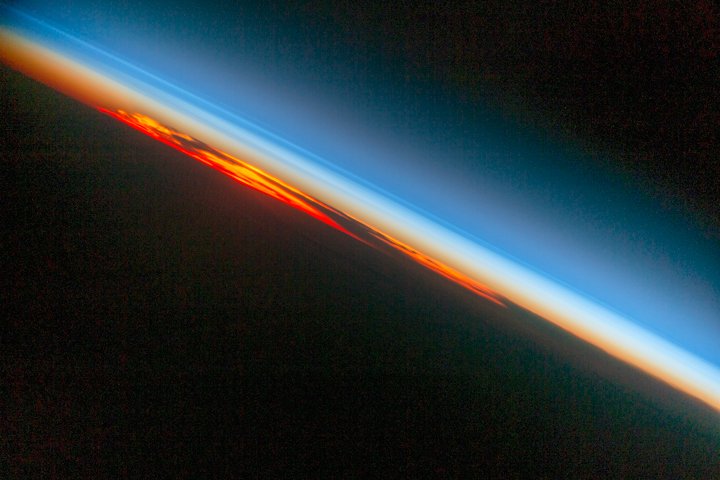[:ja]国際宇宙ステーションISSから撮影された、宇宙からの美しい日没の1枚です。高度10km程度までの対流圏がオレンジ色になっています。これはなぜでしょうか?

答えは、空気中の塵によって赤い光が散らばるからです。太陽が真上にある昼には、空気層を通る太陽光の距離が短いですが、夕方にはその距離が長くなり、これまで塵の間をすり抜けてきた波長の長い赤い光も、細かい塵にぶつかり、散らばります。
波長が短い青い光はすぐに塵にぶつかってしまい、遠くまで届きません。富士通研究所の小話(空はなぜ青くて、夕焼けはなぜ赤いのかな)にわかりやすい解説があります。
【宇宙からの地球絶景】No.69: 宇宙からの日の入りでも宇宙からの美しい日没を紹介しています。
参考文献: Fiery South Atlantic Sunset
ウェブ地球儀で地球俯瞰画像を見る: LiVEARTH
[Earthview Wonders] No.141: South Atlantic Sunset
Astronauts aboard ISS captured beautiful sunset in the South Atlantic Ocean. The troposhere layer represents fiery orange color. But why is this colored orange?

The answer is the red light is scattered by dust particles in the atmosphere. he distance of the atmosphere sunlight passes through is short during daytime, and this distance lengthens at sunset time. Red lights even with longer wavelength hit dust particles and are scattered which we see as orange. Blue lights with short wavelength are scattered at anytime.
We introduced another beautiful sunset at [Earthview Wonders] No.69: Sunset from Space.
Reference: Fiery South Atlantic Sunset
See earthview photo gallery with web-globe: LiVEARTH[:en][Earthview Wonders] No.141: South Atlantic Sunset
Astronauts aboard ISS captured beautiful sunset in the South Atlantic Ocean. The troposhere layer represents fiery orange color. But why is this colored orange?

The answer is the red light is scattered by dust particles in the atmosphere. he distance of the atmosphere sunlight passes through is short during daytime, and this distance lengthens at sunset time. Red lights even with longer wavelength hit dust particles and are scattered which we see as orange. Blue lights with short wavelength are scattered at anytime.
We introduced another beautiful sunset at [Earthview Wonders] No.69: Sunset from Space.
Reference: Fiery South Atlantic Sunset
See earthview photo gallery with web-globe: LiVEARTH[:]